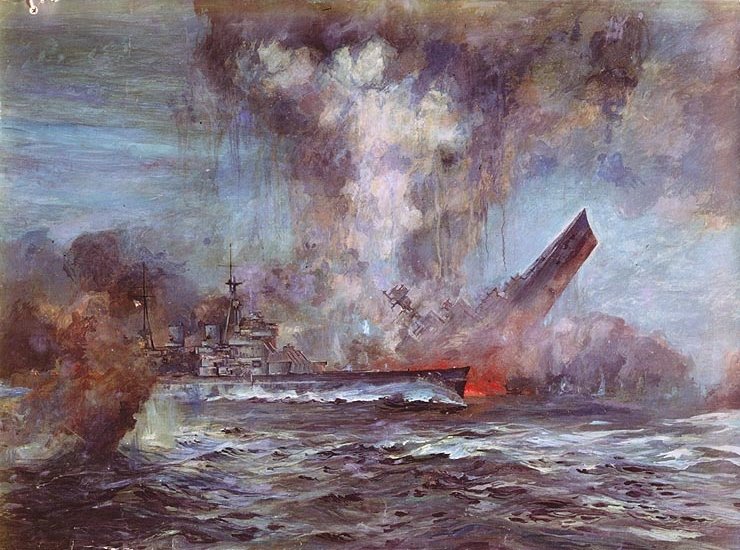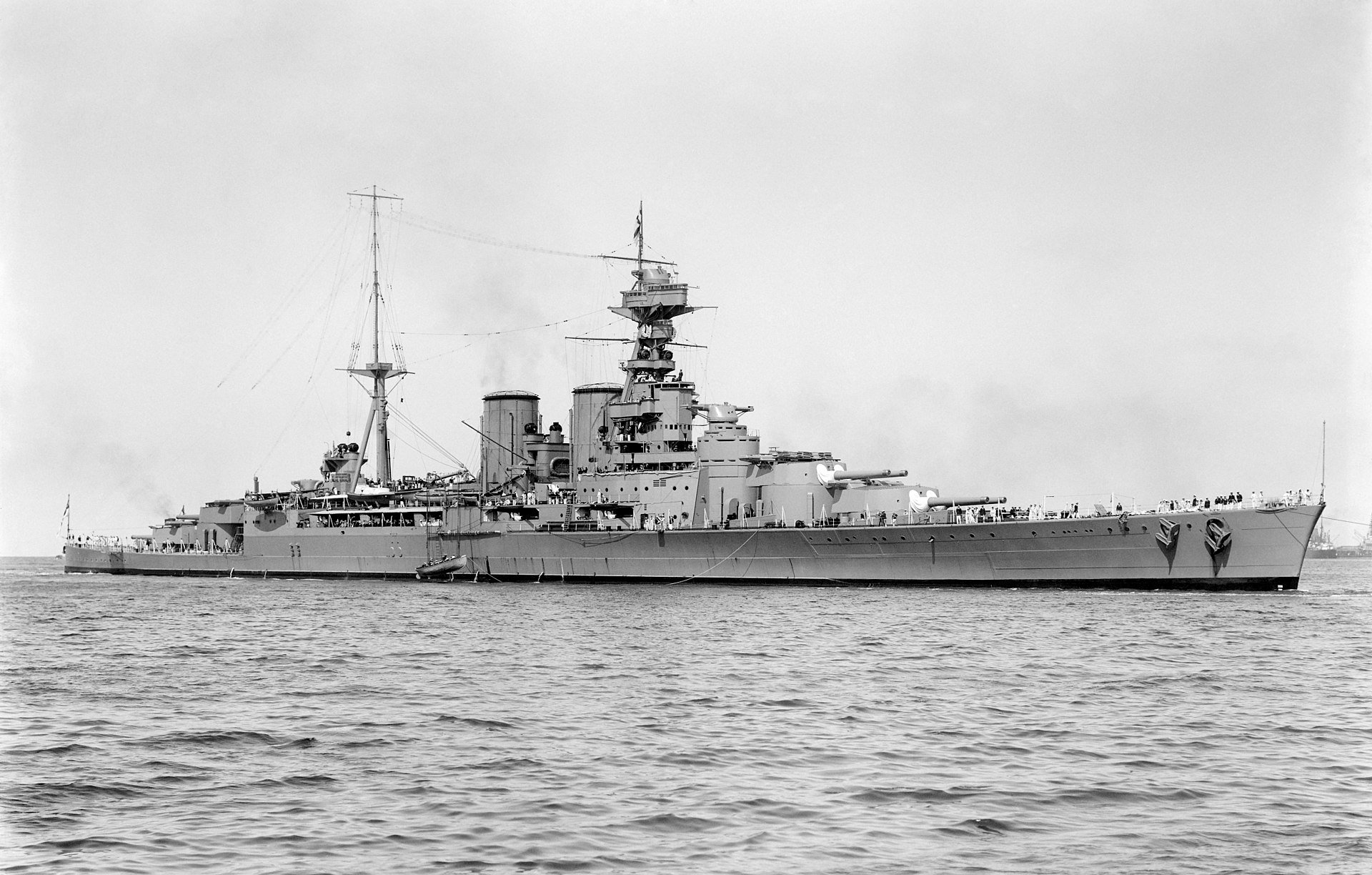Germany’s Greatest Battleship Sank Its British Rival in 3 Minutes but Couldn’t Outrun Air Power

The HMS Hood sank in under a minute, dragging most of her crew down with her. There were only three survivors. Image courtesy of J.C. Schmitz-Westerholt and the US Naval Historical Center.
In May 1941, the German Kriegsmarine revealed its newest weapon: the battle cruiser Bismarck. Germany’s largest battleship to date, the Bismarck packed heavy, carrying eight 15-inch guns in four turrets affectionately named Anton, Bruno, Cäsar, and Dora, supported by about 70 other cannons.
From the day it was launched, the Bismarck was built to take on one ship: the legendary HMS Hood, a British Royal Navy battle cruiser built for speed and covered in heavy armor, with eight 15-inch guns mounted on hydraulic turrets. Its secondary armaments included seven 4-inch high/low-angle twin guns and three eight-barrel “pom-pom” guns. During its training cruises, the Bismarck crew ran drills specifically designed to simulate the Hood’s capabilities.
If the Hood and the Bismarck were somehow destined to meet on the high seas, neither would have to wait for long.

The Battle
The Bismarck set out from Gotenhafen port (now Gdynia), Poland, May 19, 1941, accompanied by the smaller Prinz Eugen to begin Operation Rhine Exercise. The mission was to raid British commerce ships, keeping supplies from reaching English shores. The ships were under the command of Adm. Günther Lütjens, a veteran of World War I torpedo boats and an experienced officer.
On May 24, the Hood, under British Vice Adm. Sir Lancelot Holland’s command, discovered Lütjens. The Hood and the HMS Prince of Wales had the speed to keep up with the Germans, while the slower HMS Norfolk and HMS Suffolk relayed the Bismarck’s radar locations.
Holland’s fatal mistake was taking a sharp angle of approach toward the Bismarck, which maneuvered to fire accurate broadsides, hitting where the Hood’s armor was weakest.

According to shipwreck hunter David L. Mearns in his book The Shipwreck Hunter: A Lifetime of Extraordinary Discoveries on the Ocean Floor, the Hood was less than 30 seconds away from coming into position to fire with full effect when, on the Bismarck’s fifth salvo, the British ship took a shell to the right side, causing a devastating chain reaction that reached the 112 tons of cordite in the aft magazines. The explosion created a column of fire 600 feet high, ripping open the Hood’s hull.
The British ship sank in less than a minute, taking 1,415 men to their deaths as morning dawned on May 24. Only three survived the sinking when a large bubble of air escaping the sinking ship propelled them to the water’s surface. The HMS Electra picked them up two hours later.
The Bismarck had sunk its nemesis, but the Hood’s companion, the Prince of Wales, had fired a shot at the German battle cruiser, causing a fuel leak. Though it made no difference in that battle, the strike would lead to the Bismarck’s ultimate fate.
To fix the leak, Lütjens had to abandon Operation Rhine Exercise and sail to France for repairs.
Meanwhile, in London, Winston Churchill issued a navy-wide order: “Sink the Bismarck.”
The Hunt
Though the huge German ship slipped away from British pursuers, it was spotted again by a flight of torpedo planes. The squadron of 14 began an attack on the battle cruiser as the ship’s anti-aircraft weapons fired relentlessly.
“Flying at nearly wave-top height to avoid the Germans’ intensive anti-aircraft fire, the Scots pilot John Moffat dropped his single torpedo into a wave trough and watched it run true towards Bismarck’s port side,” Mearns writes. Moffat’s torpedo jammed the Bismarck’s rudders, leaving the ship to perpetually turn in circles.
When British ships arrived, they surrounded the Bismarck and fired from all sides. British guns lobbed 2,876 shells at the ship, hitting it up to 400 times, yet it stayed afloat. A torpedo volley, though, broke through, sinking the Bismarck in four minutes on May 27. The ship took 2,131 lives with it.

Experts have agreed that the Bismarck would have sunk eventually from the catastrophic damage dealt by the British, but it was likely scuttled by its own crews once its situation became hopeless.
Only 115 men survived the sinking. The death of the Bismarck crew dealt a massive blow to German morale and validated Hitler’s fear of open-sea warfare against the British navy. Hitler said of his own experiences, “On land I am a hero, at sea I am a coward.”
Discovery and Memorial
The Bismarck’s wreckage was initially found in 1989 by famed oceanographer Robert Ballard — credited with discovering the Titanic’s wreckage — and then was studied more closely by a 2001 expedition led by David Mearns. Mearns’ team laid memorial plaques on the wrecks of both the Hood and Bismarck.
Read Next:

Lauren Coontz is a former staff writer for Coffee or Die Magazine. Beaches are preferred, but Lauren calls the Rocky Mountains of Utah home. You can usually find her in an art museum, at an archaeology site, or checking out local nightlife like drag shows and cocktail bars (gin is key). A student of history, Lauren is an Army veteran who worked all over the world and loves to travel to see the old stuff the history books only give a sentence to. She likes medium roast coffee and sometimes, like a sinner, adds sweet cream to it.
BRCC and Bad Moon Print Press team up for an exclusive, limited-edition T-shirt design!
BRCC partners with Team Room Design for an exclusive T-shirt release!
Thirty Seconds Out has partnered with BRCC for an exclusive shirt design invoking the God of Winter.
Lucas O'Hara of Grizzly Forge has teamed up with BRCC for a badass, exclusive Shirt Club T-shirt design featuring his most popular knife and tiomahawk.
Coffee or Die sits down with one of the graphic designers behind Black Rifle Coffee's signature look and vibe.
Biden will award the Medal of Honor to a Vietnam War Army helicopter pilot who risked his life to save a reconnaissance team from almost certain death.
Ever wonder how much Jack Mandaville would f*ck sh*t up if he went back in time? The American Revolution didn't even see him coming.
A nearly 200-year-old West Point time capsule that at first appeared to yield little more than dust contains hidden treasure, the US Military Academy said.












